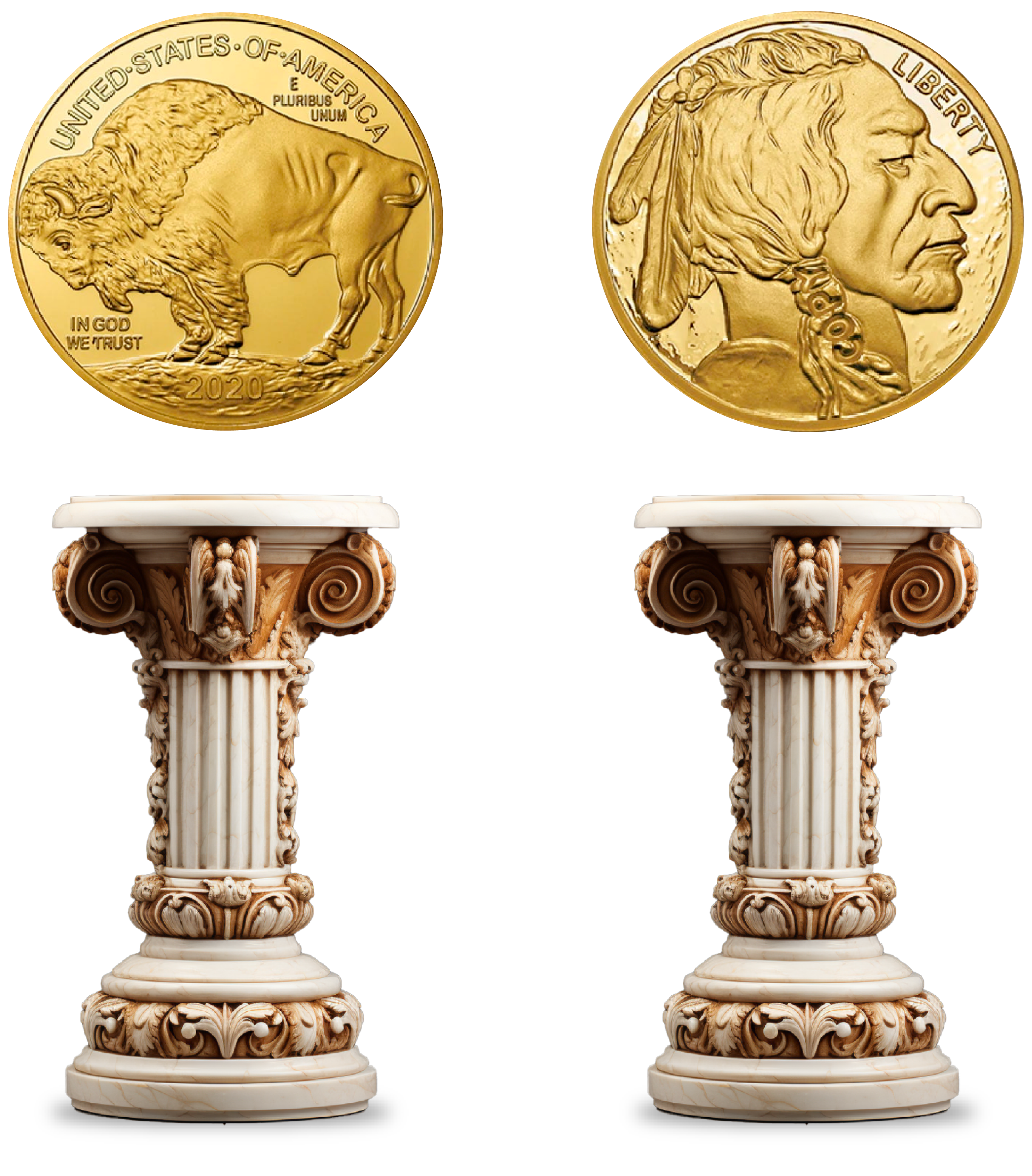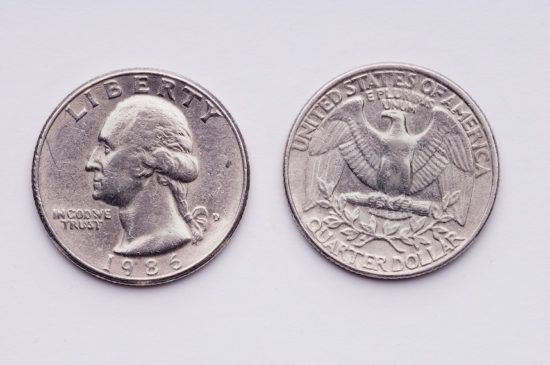
BUFFALO TRIBUTE PROOF COIN
THE HOTTEST COIN ON THE MARKET
How Much Does A Quarter Weigh?

As children, we were very excited to discover a quarter left under our pillow by the tooth fairy. We may have wondered whether it was silver. Many adults still have questions about quarters, such as, “What are they made of?” and, “How much do they weigh?”
The answers to these questions are not as simple as you may think. The quarter has changed many times over the years to fit the needs of the era.
What Are Quarters Made Of?
It’s a common misconception that some of the coins in our pockets are made of precious metals. There was a time in U.S. history that circulating coins did consist of gold and silver released by the U.S. Mint. As the prices of these metals increased, minting coins out of them became impractical. Early U.S. quarters were made of silver, but they were composed of 90% silver and 10% copper from 1873 to 1964. Today, quarters are made of a much less costly combination of copper and nickel.
How Is Silver Measured?
The U.S. quarters minted before 1965 contain 0.1808 troy ounces (6.25 grams) of physical silver. But what is a troy ounce? A troy ounce is a unit of measure used for weighing precious metals that dates back to the Middle Ages. Initially used in Troyes, France, 1 troy ounce is equal to 31.1034768 grams, according to the UK Royal Mint. Other items, such as sugar and grain, were measured in standard ounces: 1 standard ounce weighed slightly less – 28.35 grams.
Some historians believe the troy ounce had its origins in Roman times. Romans standardized their monetary system using bronze bars that could be broken down into 12 pieces called “uncial” (ounce). Each piece weighed about 31.1 grams. This unit of measurement became important as trade in Europe expanded. Weighing precious metals accurately by using this system became a necessity for commerce.
The troy ounce is retained even today as the standard unit of measurement in the precious metals market to ensure purity standards, and other common measures remain consistent over time.
So How Much Does A Quarter Weigh?
When the U.S. was still a young country, the federal government passed the Coinage Act of 1792. It established the U.S. dollar and dictated the required weights for different coins, including a new 25-cent piece. The new quarter was to weigh 0.211 ounces (6.01 grams) pure silver, or 0.237 standard ounces (6.74 grams). These weights lasted until the Coinage Act of 1873, when U.S. quarters began to be composed of 90% silver and 10% copper, with a slightly heavier weight of 0.022 ounces (6.25 grams).
Since 1965, coin specifications of U.S. quarters have weighed 0.2 ounces (5.76 grams). They have a diameter of 24.66 mm and a thickness of 1.75 mm, and they’re primarily composed of a “clad sandwich” of copper (91.67%) on the inside with nickel (8.33%) plating on the outside.

Do All Quarters Weigh The Same?
U.S. quarters have slightly different weights due to the historical use of different materials. Over the years, many different variations of quarters have been created:
Draped Bust Quarter: The Draped Bust quarters were minted from 1796 to 1807. These valuable quarters each weigh 6.74 grams. Probably around 10% of the original mintage of 6,146 survives in some grade, though most are in the About Good to Fine range. Being a one-year type, and a scarce one at that, enough was saved in mid-grade so that V.F. to A.U. coins can be located, though at a mid-five-figure price. Uncirculated pieces are also known, and these will typically set you back more than $100,000.
The 1796 quarter is a key issue in any grade and is a landmark in the U.S. coinage series. Quarter dollars minted from 1804 through 1807 continue the Draped Bust obverse first used in 1796, though the star count was reduced from 15 stars to 13, with seven at the left and six to the right.
- Capped Bust Quarter: The Capped Bust quarter was first minted in 1815 with a weight of 6.74 grams. For the years 1837 and 1838, the weight changed slightly to 6.7 grams. Following a suspension of quarter coinage after 1807, the denomination was again produced in 1815, at which time the Capped Bust style was introduced. The motifs are similar to those found on other silver denominations of the period, first seen on the half dollar of 1807.
- Seated Liberty Quarter: The commemorative Seated Liberty quarter was first minted in 1838 with a weight of 6.68 grams. The weight changed to 6.22 grams in 1853, and then in 1873, there was a small increase to 6.25 grams. The design was produced continuously from 1838 through early 1853 and again from 1856 through 1865. Early issues lack drapery at Liberty’s elbow. Some issues dated 1853, and all those dated 1854 and 1855 display arrows. Along with the other silver denominations, quarters were reduced in weight in 1853 as a measure against the hoarding and melting of newly released pieces. The authorized weight, previously 103.125 grains, was lowered to 96 grains. In 1873, the authorized weight of the quarter dollar was slightly raised from 96 to 96.45 grains. To signify the new standard, arrows were added to the date of quarters produced later in 1873 and all those produced in 1874. After 1874, the weight remained the same, but the arrows were no longer used.
- Silver Quarters: The more-common silver quarters weigh 6.25 grams. Every silver quarter minted from 1873 to 1964 has the same weight of 6.25 grams. This includes all of the silver U.S. coins, Washington quarters, Standing Liberty quarters, and Barber quarters. These quarters consist of 90% silver and 10% copper. You are unlikely to find them in circulation, but you can sell them as bullion or individually as collectible coins.
- Early Silver Quarters: These rare, early-issue silver quarters have different weight variations, depending on the series. Note that these older silver coins quarters are entirely out of circulation and can only be bought as collectible coins. So unless you are a collector, then you will likely never come across them.
- Clad Quarters: Any U.S. quarter minted after 1964 is a clad coin that weighs 5.670 grams. Mostly these are everyday quarters that will be found in your change. They consist of 91.67% copper and 8.33% nickel.
What Is Cupronickel?
Many people do not realize that the popular silver quarter was replaced with a more cost-effective combination. Due to the abundant supply available of copper, nickel, and zinc, this mix has become the prominent quarter composition that we all know as the modern-day quarter coin. Ironically enough, copper and nickel is a unique element combination used in the industry.
The quarter, nickel, and dime include a copper-nickel combination called cupronickel. This durable, corrosion-resistant alloy is an inexpensive easy to produce a circulating coin in bulk. In the United States coinage, cupronickel is often found in a 3-to-1 ratio of copper to nickel. In other applications, such as the automotive industry or the marine industry, the proportion is higher or lower depending on the need.
Cupronickel is also used in many different ways, such as shipbuilding and ship repair. Its cost-effectiveness and solid-state of the element lend itself to perfect use in high-pressure applications. It is also used in construction as reinforcements for beams and load-bearing structures. Strengthening elements are added to the cupronickel. It is not uncommon for cupronickel to include iron or manganese. Other elements, such as zinc and chromium, have also been used to add strength to cupronickel. Cupronickel is also recyclable, meaning that it can be reused without losing its chemical properties.
Taking A Closer Look At Coins
The quarter has a fascinating history and its present is also interesting. For example, the specifications of the popular state quarters are quite varied and incorporate unique, state-specific elements in their designs.
Are you interested in more facts about other coins? Then it’s worth looking into how much a nickel weighs, a dime weighs, and a penny weighs.

